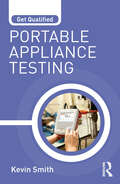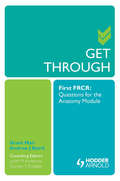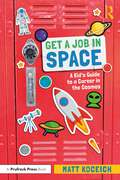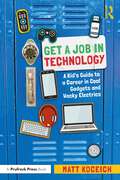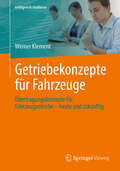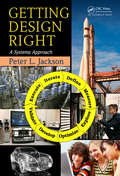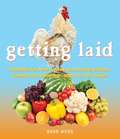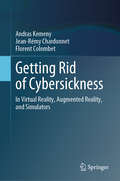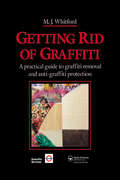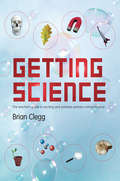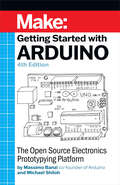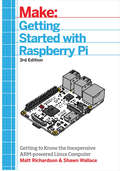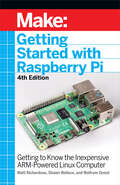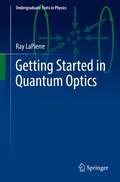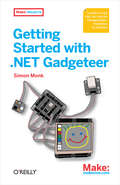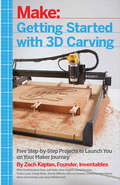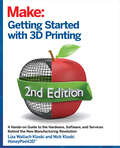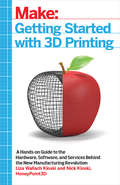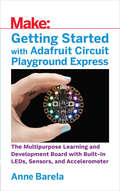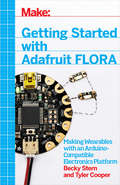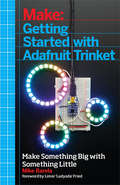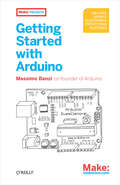- Table View
- List View
Get Qualified: Inspection And Testing
by Kevin SmithThe Get Qualified series provides clear and concise guidance for people looking to work within the electrical industry. This book outlines why the inspection and testing of electrical installations is important, and what qualifications are required in order to test, inspect and certify. All you need to know about the subject of inspection is covered in detail, making this book the ideal guide for those who are new to the subject and experienced professionals alike. There are also sections on exam preparation, revision exercises and sample questions.
Get Qualified: Portable Appliance Testing (Get Qualified)
by Kevin SmithThis book contains essential advice and guidance for those thinking of starting out in the Portable appliance testing industry. A detailed look at the subject of Portable Appliance Testing (PAT), this book is the ideal accompaniment for those studying the City & Guild and EAL PAT courses. Theory and assessment covered in one volume, with advice, revision exercises and sample tests to aid exam preparation. Contains all the information required to qualify and begin testing portable appliances. The Get Qualified series provides clear and concise guidance for people looking to work within the electrical industry. This book clearly explains the options available to those wishing to enter the portable appliance testing industry and supports the reader through the subject in a step-by-step manner. Most importantly, it covers the theory behind portable appliance testing as well as looking in detail at each exam learning outcome. There are also sections on exam preparation, revision exercises and sample questions.
Get Started on Android with TalkBack 12.2
by Bookshare IndiaThis is a complete guide for using 'Talkback' with android devices. it It explains in details the various options offered to Blind and Low vision users for using the 'Talkback' screen reader for optimum use of their android devices.
Get Through First FRCR: Questions for the Anatomy Module (Get Through)
by Judith Anderson Grant Mair Andrew Baird Gordon FindlaterCompletely up to date with the latest exam changes, Get Through First FRCR: Questions for the Anatomy Module offers a valuable insight into the new anatomy exam. 170 high quality practice cases, each containing 5 question stems, are presented according to syllabus topics, accurately reflecting the content, style and level of difficul
Get a Job in Space: A Kid's Guide to a Career in the Cosmos
by Matt KoceichGet a Job in Space is your one-stop-shop to learning everything there is to know about working in space…and the STEM subjects you need to get there! From celestial science to intergalactic technology, discover what astronauts, technicians and engineers need to know to do their jobs. Would you rather study how plants grow on Mars than design a rocket? Explore your perfect career match, and dive into additional resources, classes and tips to help launch you into space. This book is a must-have for kids fascinated by the cosmos, astronauts and the people who get them there.
Get a Job in Technology: A Kid's Guide to a Career in Cool Gadgets and Wacky Electrics
by Matt KoceichGet a Job in Technology is your one-stop-shop to learning everything there is to know about working in tech…and the STEM subjects you need to get there! From techno math to smartphone science, discover what computer engineers, video game designers and programmers need to know to do their jobs. Would you rather design a video game than build a cell phone? Explore your perfect career match, and dive into additional resources, classes and tips. This book is a must-have for kids fascinated by awesome gadgets and the people who build them.
Getriebekonzepte für Fahrzeuge: Übertragungskonzepte für Fahrzeugantriebe – heute und zukünftig (erfolgreich studieren)
by Werner KlementAuf Grundlage von Konzeptfahrzeugen werden die spezifischen Anforderungen an Getriebe je nach Antriebskonzept erarbeitet und die technischen Möglichkeiten aufgezeigt. Dabei werden zunächst grundlegende Aspekte wie der Leistungsfluss abgeleitet und anhand praktischer Beispiele verdeutlicht. Es werden Lösungen sowohl für Verbrennungsmotoren in PKW als auch für LKW beschrieben. Im Bereich der Ackerschlepper spielen stufenlose Getriebekonzepte eine bedeutende Rolle. Bei alternativen Fahrzeugantrieben werden die Möglichkeiten von Hybridlösungen sowie die Notwendigkeit einer geeigneten Übersetzung für elektrische Antriebe behandelt. Der Fokus liegt dabei stets auf der Fahrzeuganwendung und den daraus resultierenden Anforderungen an die Übertragungskomponenten bei gegebener Energiequelle. Getriebe sind keine eigenständigen Produkte, sondern fungieren als „Übersetzer“, die passgenau die Anforderungen des jeweiligen Fahrzeugs erfüllen müssen. Oft ergibt sich daraus eine ganzheitliche Lösung, die in Bezug auf Performance und Wirkungsgrad Standardanwendungen überlegen ist. Zahlreiche Beispiele verdeutlichen diese Symbiose und die damit einhergehende Verbesserung der Gesamtsysteme.
Getting Design Right: A Systems Approach
by Peter L. JacksonFilling a new need in engineering education, Getting Design Right: A Systems Approach integrates aspects from both design and systems engineering to provide a solid understanding of the fundamental principles and best practices in these areas. Through examples, it encourages students to create an initial product design and project plan.Classroom-te
Getting Energy Prices Right: From Principle to Practice
by International Monetary FundA report from the International Monetary Fund.
Getting Laid
by Barb WebbSustainable living boasts no boundaries. You don’t need massive amounts of acreage or even a fenced-in backyard. We may not be 100 percent sustainable in our lifestyle, but we can become better in-tune with our environment and conscientious of our actions. Like all aspects of life, it’s about balance, finding ways to live a greener, cleaner life within the parameters of your current lifestyle. Top blogger for country living, Rural Mom, shows us the (actually very easy) way to live a sustainable lifestyle without making ourselves crazy in the process. Why does even Jennifer Aniston raise chickens in the Hollywood Hills? Easy answer, it is extremely cool to raise you own hens. Eat the organic eggs and lie back on feather beds from your own brood. And what about you? Author Barb Webb believes there's a farm girl in all of us and she helps you find yours! What initially drew you to the idea of raising chickens, organic gardening and incorporating more sustainable living practices into your lifestyle? Are you interested in saving money, eating a more healthy diet, being on trend, going more "green,” or saving the planet one plant at a time? Whatever the reason, the good new is all of the above motivators are real, tangible end-results of sustainable living. SUSTAINABLE LIVING IS. . . a) reducing your carbon footprint b) eating organic and "living off the land” c) living in harmony with the earth d) using resources efficiently and investing in renewable resources e) creating a better future for the next generation f) protecting and nurturing our natural resources g) eliminating waste and recycling h) actively pursuing a balanced and simplistic lifestyle i) spending money and resources in a frugal way j) our economy, social structure and natural environment working in agreement for the betterment of the world Sustainable living has many definitions and interpretations that have developed over time. In its basic definition, the Merriam Webster Dictionary defines sustainable as "able to be used without being completely used up or destroyed,” and living as "full of life or vigor. ” In a nutshell - as sustainable living agents, we are ultimately defenders, maintainers and supporter of life! Our mission is of the utmost importance to ourselves, our environment and our future generations. Our mission is also easy. In fact, it takes less than five minutes to incorporate one sustainable living practice into your life right now but the effect of your action may have an ever-lasting positive impact for the world.
Getting Rid of Cybersickness: In Virtual Reality, Augmented Reality, and Simulators
by Andras Kemeny Jean-Rémy Chardonnet Florent ColombetThis book provides a concise overview of VR systems and their cybersickness effects, giving a description of possible reasons and existing solutions to reduce or avoid them. Moreover, the book explores the impact that understanding how efficiently our brains are producing a coherent and rich representation of the perceived outside world would have on helping VR technics to be more efficient and friendly to use.Getting Rid of Cybersickness will help readers to understand the underlying technics and social stakes involved, from engineering design to autonomous vehicle motion sickness to video games, with the hope of providing an insight of VR sickness induced by the emerging immersive technologies. This book will therefore be of interest to academics, researchers and designers within the field of VR, as well as industrial users of VR and driving simulators.
Getting Rid of Graffiti: A practical guide to graffiti removal and anti-graffiti protection
by Maurice J. WhitfordThis book provides, for the first time, clear, authoritative guidance on removing graffiti and protecting surfaces from further attack.
Getting Science: The Teacher's Guide to Exciting and Painless Primary School Science
by Brian CleggScience is rightly a fundamental part of primary school education, but that doesn’t make it easy to teach - especially for teachers without a science background. This straight talking book from an experienced science writer and communicator looks at how to make the most of it and give primary school children a good grounding in the topic. Getting Science sets out to engage the sense of wonder. The science in this book is not for the children, but for the adults who have to explain it. Starting with a whirlwind tour of the great milestones of modern science, Getting Science goes on to take each of the main curriculum topics and give it a new twist. It provides the information needed to understand the key topics better and be able to put them across with enthusiasm and energy. This book will help teachers to get children excited by science, to understand science rather than just answer questions. Getting Science makes science fun, approachable and comprehensible to those who just don’t get it.
Getting Started With Arduino: The Open Source Electronics Prototyping Platform
by Massimo Banzi Michael ShilohArduino is the open source electronics prototyping platform that has taken the Maker Movement by storm. This thorough introduction, updated for the latest Arduino release, helps you start prototyping right away. From obtaining the required components to putting the final touches on your project, all the information you need is here!Getting started with Arduino is a snap. To use the introductory examples in this guide, all you need is an Arduino Uno or Leonardo, along with a USB cable and an LED. The easy-to-use, free Arduino development environment runs on Mac, Windows, and Linux.In Getting Started with Arduino, you'll learn about:Interaction design and physical computingThe Arduino board and its software environmentBasics of electricity and electronicsPrototyping on a solderless breadboardDrawing a schematic diagramTalking to a computer--and the cloud--from ArduinoBuilding a custom plant-watering system
Getting Started With Raspberry Pi: An Introduction to the Fastest-Selling Computer in the World
by Shawn Wallace Matt RichardsonThe Raspberry Pi is a credit card-sized computer that plugs into your TV and a keyboard. It is a capable little computer which can be used in electronics projects, and for many of the things that your desktop PC does, like spreadsheets, word processing, browsing the internet, and playing games. It also plays high-definition video. This book takes you step-by-step through many fun and educational possibilities. Take advantage of several preloaded programming languages. Use the Raspberry Pi with Arduino. Create Internet-connected projects. Play with multimedia. With Raspberry Pi, you can do all of this and more.
Getting Started With Raspberry Pi: Getting to Know the Inexpensive ARM-Powered Linux Computer
by Shawn Wallace Matt Richardson Wolfram DonatThe Raspberry Pi is a credit card-sized computer that plugs into your TV and a keyboard. It is a capable little computer which can be used in electronics projects, and for many of the things that your desktop PC does, like spreadsheets, word processing, browsing the internet, and playing games. It also plays high-definition video. This book takes you step-by-step through many fun and educational possibilities. Take advantage of several preloaded programming languages. Use the Raspberry Pi with Arduino. Create Internet-connected projects. Play with multimedia. With Raspberry Pi, you can do all of this and more.
Getting Started in Quantum Optics (Undergraduate Texts in Physics)
by Ray LaPierreThis book, based on classroom-tested lecture notes, provides a self-contained one semester undergraduate course on quantum optics, accessible to students (and other readers) who have completed an introductory quantum mechanics course and are familiar with Dirac notation and the concept of entanglement. The book covers canonical quantization, the harmonic oscillator, vacuum fluctuations, Fock states, the single photon state, quantum optical treatment of the beam splitter and the interferometer, multimode quantized light, and coherent and incoherent states. Metrology is a particular area of emphasis, with the book culminating in a treatment of squeezed light and its use in the laser interferometer gravitational-wave observatory (LIGO). The Heisenberg limit is described, along with NOON states and their application in super-sensitivity, super-resolution and quantum lithography. Applications of entanglement and coincidence measurements are described including ghost imaging, quantum illumination, absolute photodetector calibration, and interaction-free measurement. With quantum optics playing a central role in the so-called “second quantum revolution,” this book, equipped with plenty of exercises and worked examples, will leave students well prepared to enter graduate study or industry.
Getting Started with .NET Gadgeteer: Learn to Use This .NET Micro Framework-Powered Platform
by Simon MonkLearn how to quickly build cool electronic gadgets with .NET Gadgeteer. With the easy-to-follow instructions in this guide, you’ll tackle five fascinating projects, using Microsoft’s rapid prototyping Gadgeteer platform. There’s no soldering involved—you simply plug in modules that make gadget-building quick and easy.Ideal for beginners, this book shows you how to work with modules and other hardware in the popular Fez Spider Starter Kit, and teaches you how to program your gadgets with Visual Studio C# Express and the .NET Micro Framework 4.1 SDK. You’ll soon learn a wide range of programming techniques along with the skills to design your own projects.Get to know the software and hardware with a simple LED projectDownload code from the companion site to build and test each projectBuild a spy camera that automatically captures and saves images at regular intervalsConstruct a simple animated game with the joystick moduleCreate a web server that sends messages you draw or write on the touchscreen moduleBuild a gadget that backs up digital images from an SD card to a USB flash driveLearn about other .NET Gadgeteer modules for creating environmental sensors, an MP3 player, and a WiFi network
Getting Started with 3D Carving: Five Step-by-Step Projects to Launch You on Your Maker Journey
by Zach Kaplan3D printing has been the hot topic in the maker world for years now, but there's another type of desktop manufacturing that's become the go-to choice for anyone who needs durable results fast. Instead of slowly depositing layers of plastic, a 3D carver starts with a solid block of material and carves it away using a rotating metal bit. It's faster than 3D printing, offers a wider choice of materials, and creates durable, permanent parts that look great. This book covers the basics of designing and making things with a 3D carver, and gives you several projects you can build yourself including a guitar, clock, earrings, and even a skateboard.
Getting Started with 3D Printing
by Liza Wallach Kloski Nick KloskiThe book is written in a casual, conversational style. It is easily accessible to those who have no prior knowledge in 3D printing, yet the book's message is solidly practical, technically accurate, and consumer-relevant. The chapters include contemporary, real-life learning exercises and insights for how to buy, use and maintain 3D printers. It also covers free 3D modeling software, as well as 3D printing services for those who don't want to immediately invest in the purchase of a 3D printer. Particular focus is placed on free and paid resources, the various choices available in 3D printing, and tutorials and troubleshooting guides.
Getting Started with 3D Printing: A Hands-on Guide to the Hardware, Software, and Services Behind the New Manufacturing Revolution
by Liza Wallach Kloski Nick KloskiMake: Getting Started with 3D Printing is a practical, informative, and inspiring book that guides readers step-by-step through understanding how this new technology will empower them to take full advantage of all it has to offer. The book includes fundamental topics such as a short history of 3D printing, the best hardware and software choices for consumers, hands-on tutorial exercises the reader can practice for free at home, and how to apply 3D printing in the readers' life and profession. For every maker or would-be maker who is interested, or is confused, or who wants to get started in 3D printing today, this book offers methodical information that can be read, digested, and put into practice immediately!
Getting Started with Adafruit Circuit Playground Express: The Multipurpose Learning and Development Board with Built-In LEDs, Sensors, and Accelerometer
by Anne BarelaFrom Adafruit Industries, a leader in products to Makers, designers, students young and old, comes the Circuit Playground Express. Connect it to your PC, Mac or Linux computer, and you can be programming interactive projects in minutes. You have a choice of programming environments to choose from: Python, the Microsoft MakeCode graphical building block environment, C/C++ via the Arduino development environment and JavaScript. Whether you are learning interactive programming, have an Internet of Things project in mind, or are looking to design on-the-go wearable electronics, the versatile Circuit Playground Express is the device to start with. In Getting Started with the Adafruit Circuit Playground Express, you'll learn how to:Get up and running quickly with programmable boardsUnderstand the basics of coding in multiple programming languagesUse the built-in sensors for a variety of projectsMake colorful interactive displaysDesign programs for the Internet of Things (IoT)
Getting Started with Adafruit FLORA: Making Wearables with an Arduino-Compatible Electronics Platform
by Tyler Cooper Becky SternThis book introduces readers to building wearable electronics projects using Adafruit's tiny FLORA board: at 4.4 grams, and only 1.75 inches in diameter, and featuring Arduino compatibility, it's the most beginner-friendly way to create wearable projects. This book shows you how to plan your wearable circuits, sew with electronics, and write programs that run on the FLORA to control the electronics. The FLORA family includes an assortment of sensors, as well as RGB LEDs that let you add lighting to your wearable projects.
Getting Started with Adafruit Trinket: 15 Projects with the Low-Cost AVR ATtiny85 Board
by Mike BarelaArduino's ubiquity and simplicity has led to a gigantic surge in the use of microcontrollers to build programmable electronics project. Despite the low cost of Arduino, you're still committing about $30 worth of hardware every time you build a project that has an Arduino inside. This is where Adafruit's Trinket comes in. Arduino-compatible, one-third the price, and low-power, the Trinket lets you make inexpensive and powerful programmable electronic projects. Written by one of the authors of Adafruit's Trinket documentation, Getting Started with Trinket gets you up and running quickly with this board, and gives you some great projects to inspire your own creations.
Getting Started with Arduino: The Open Source Electronics Prototyping Platform (Make: Projects)
by Massimo BanziThis valuable little book offers a thorough introduction to the open-source electronics prototyping platform that's taking the design and hobbyist world by storm. Getting Started with Arduino gives you lots of ideas for Arduino projects and helps you get going on them right away. From getting organized to putting the final touches on your prototype, all the information you need is right in the book. Inside, you'll learn about:Interaction design and physical computingThe Arduino hardware and software development environmentBasics of electricity and electronicsPrototyping on a solderless breadboardDrawing a schematic diagramAnd more. With inexpensive hardware and open-source software components that you can download free, getting started with Arduino is a snap. To use the introductory examples in this book, all you need is a USB Arduino, USB A-B cable, and an LED.Join the tens of thousands of hobbyists who have discovered this incredible (and educational) platform. Written by the co-founder of the Arduino project, with illustrations by Elisa Canducci, Getting Started with Arduino gets you in on the fun! This 128-page book is a greatly expanded follow-up to the author's original short PDF that's available on the Arduino website.

